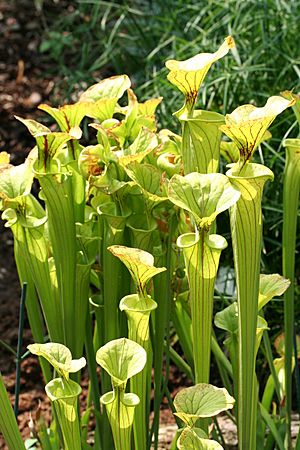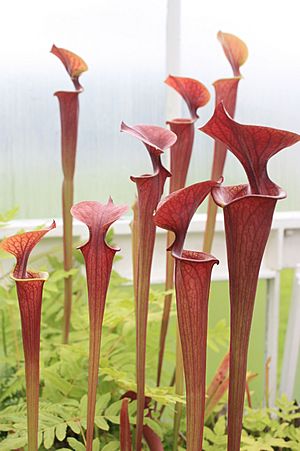Yellow pitcherplant facts for kids
Quick facts for kids Yellow pitcher plant |
|
|---|---|
 |
|
| Conservation status | |
| Scientific classification | |
| Genus: |
Sarracenia
|
| Species: |
flava
|
 |
|
| Sarracenia flava range | |
The yellow pitcher plant, known scientifically as Sarracenia flava, is a very special type of carnivorous plant. This means it gets some of its food by trapping and eating insects! It belongs to the Sarraceniaceae family. Like all plants in this family, it grows naturally in the New World, which includes North and South America.
You can find the yellow pitcher plant growing in the wild from southern Alabama all the way through Florida and Georgia. It also lives along the coastal areas of southern Virginia, North Carolina, and South Carolina. Some groups of these plants even grow in the Piedmont and mountains of North Carolina.
Contents
Yellow Pitcher Plant: A Carnivorous Wonder
This amazing plant uses its leaves to catch bugs. The leaves are rolled up to form a tube, just like a pitcher. These pitcher-shaped leaves are usually a bright yellow color. They can grow quite tall, sometimes over a meter (3 feet) high. However, they are more often around 50 centimeters (20 inches) tall.
How It Catches Bugs
The very top part of the pitcher leaf opens up into a lid. This lid is called the operculum. It helps stop too much rain from falling into the pitcher. If too much rain got in, it would water down the special liquids inside that help the plant digest its prey.
The upper parts of the pitcher are covered with short, stiff hairs. These hairs point downwards. They act like tiny arrows, guiding insects that land on the leaf towards the opening of the pitcher tube. This part of the pitcher also has bright patterns. These patterns look like flowers and help attract insects. You can see these patterns especially well in varieties like S. flava var. rugelii and S. flava var. ornata.
The opening of the pitcher tube has a special rolled edge. This is called a 'nectar roll' or peristome. This edge is covered with glands that make sweet nectar. This nectar not only has sugars to attract insects, but also a substance called coniine. Coniine is a toxin that can make the insects dizzy or even paralyze them.
Once an insect enters the tube, it finds it very hard to keep its footing. The surfaces inside the upper part of the tube are super smooth and covered in a waxy coating. Insects that lose their grip on this slippery surface fall to the bottom of the tube. At the bottom, there's a mix of digestive fluid and other liquids. Plus, there are more hairs pointing inwards, making it almost impossible for the insect to climb back out. While most insects are trapped, some larger ones, like wasps, have been seen chewing their way out of the pitcher wall to escape!
Its Amazing Flowers
In the spring, the yellow pitcher plant grows large, beautiful flowers. These flowers have five petals and are symmetrical. The yellow petals are long and hang down over the flower's umbrella-like center. This center, called the style, is held upside down at the end of a long stalk, about 50 centimeters (20 inches) tall.
The parts of the flower that receive pollen, called the stigma, are found at the tips of the 'spokes' of this umbrella shape. When insects come to pollinate, they usually enter the flower from above. They push their way into the space between the petals and the umbrella. As they enter, they leave any pollen they are carrying on the stigmas. To leave the flower, the pollinators usually lift a petal. This clever one-way system helps make sure the plant gets cross pollination, which means it gets pollen from a different plant.
Seasonal Changes
In late summer and autumn, the yellow pitcher plant stops making its carnivorous pitcher leaves. Instead, it grows flat, non-carnivorous leaves called phyllodia. This change probably helps the plant survive when there isn't much sunlight or as many insects around during the winter months. It also shows that making and using those amazing pitcher traps takes a lot of energy!
Growing Your Own Yellow Pitcher Plant
The yellow pitcher plant is quite easy to grow. Because of this, it's one of the most popular carnivorous plants for people to keep in their gardens or homes.
This plant also easily mixes with other Sarracenia species to create new types, called hybrids. For example, S. x catesbaei is a natural hybrid of S. flava and S. purpurea. Another popular hybrid is S. moorei, which comes from S. flava and S. leucophylla. You can find these hybrids growing in the wild, and many plant collectors love to grow them too.
Images for kids
See also
 In Spanish: Planta carnívora amarilla para niños
In Spanish: Planta carnívora amarilla para niños






